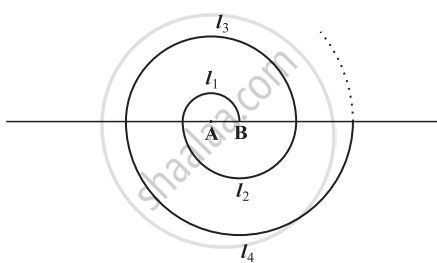Advertisements
Advertisements
प्रश्न
If the sum of the first n terms of an AP is 4n − n2, what is the first term (that is, S1)? What is the sum of the first two terms? What is the second term? Similarly, find the 3rd, the 10th, and the nth terms.
उत्तर १
Given that,
Sn = 4n − n2
First term, a = S1 = 4(1) − (1)2
= 4 − 1
= 3
sum of first two terms is S2
= 4(2) − (2)2
= 8 − 4
= 4
Second term (a2) = S2 - S1 = 4 - 3 = 1
S3 = 4(3) - (3)2 = 12 - 9 = 3
sum of first 3 terms is 3
Third term (a3) = S3 - S2 = 3 - 4 = -1
S9 = 4(9) - (9)2
= 36 - 81
= -45
S10 = 4(10) - (10)2
= 40 - 100
= -60
S10 - S9 = -60 - (-45) = -15
Now, Sn = 4n - n2
Also, `S_(n - 1)` = 4(n - 1) - (n - 1)2
= 4n - 4 - [n2 - 2n + 1]
= 4n - 4 - n2 + 2n - 1
= 6n - n2 - 5
nth term = Sn - Sn - 1 = (4n - n2) - (6n - n2 - 5)
= 4n - n2 - 6n + n2 + 5
= 5 - 2n
Thus, S1 = 3 and a1 = 3
S2 = 4 and a2 = 1
S3 = 3 and a3 = -1
a10 = -15 and an = 5 - 2n
उत्तर २
In the given problem, the sum of n terms of an A.P. is given by the expression,
Sn = 4n -n2
So here, we can find the first term by substituting n = 1 ,
Sn = 4n -n2
S1 = 4(1) - (1)2
= 4 - 1
= 3
Similarly, the sum of first two terms can be given by,
S2 = 4(2) - (2)2
= 8 - 4
= 4
Now, as we know,
an = Sn - Sn-1
So,
a2 = S2 - S1
= 4 - 3
= 1
Now, using the same method we have to find the third, tenth and nth term of the A.P.
So, for the third term,
a3 = S3 - S2
= `[4(3)-(3)^2]-[4(2)-(2)^2]`
= `(12-9)-(8-4)`
= 3 - 4
= -1
Also, for the tenth term,
`a_10 = A_10 - S_9`
= `[4(10)-(10)^2]-[4(9)-(9)^2]`
= (40 - 100) - (36 - 81)
= -60 + 45
= -15
So, for the nth term,
`a_n = S_n - S_(n-1)`
= `[4(n)-(n)^2]-[4(n-1)-(n-1)^2]`
= `(4n -n^2)-(4n-4-n^2 - 1 + 2n)`
= `4n - n^2 - 4n + 4 + n^2 + 1 -2n`
= 5 - 2n
Therefore, `a = 3 , S_2 = 4 , a_2 = 1 , a_3 = -1 , a_10 = -15`.
संबंधित प्रश्न
If the sum of first 7 terms of an A.P. is 49 and that of its first 17 terms is 289, find the sum of first n terms of the A.P.
If Sn denotes the sum of first n terms of an A.P., prove that S30 = 3[S20 − S10]
In an AP given d = 5, S9 = 75, find a and a9.
A spiral is made up of successive semicircles, with centres alternately at A and B, starting with centre at A of radii 0.5, 1.0 cm, 1.5 cm, 2.0 cm, .... as shown in figure. What is the total length of such a spiral made up of thirteen consecutive semicircles? (Take `pi = 22/7`)

[Hint: Length of successive semicircles is l1, l2, l3, l4, ... with centres at A, B, A, B, ... respectively.]
Find the sum to n term of the A.P. 5, 2, −1, −4, −7, ...,
Find the sum of all natural numbers between 1 and 100, which are divisible by 3.
Find the sum of the first 13 terms of the A.P: -6, 0, 6, 12,....
The sum of n natural numbers is 5n2 + 4n. Find its 8th term.
Find the middle term of the AP 10, 7, 4, ……., (-62).
Find the 8th term from the end of the AP 7, 10, 13, ……, 184.
If 4 times the 4th term of an AP is equal to 18 times its 18th term then find its 22nd term.
Find the common difference of an AP whose first term is 5 and the sum of its first four terms is half the sum of the next four terms.
How many two-digits numbers are divisible by 3?
Write the next term of the AP `sqrt(2) , sqrt(8) , sqrt(18),.........`
Find the sum of all 2 - digit natural numbers divisible by 4.
In an A.P. the first term is 8, nth term is 33 and the sum to first n terms is 123. Find n and d, the common differences.
The sum of first seven terms of an A.P. is 182. If its 4th and the 17th terms are in the ratio 1 : 5, find the A.P.
Shubhankar invested in a national savings certificate scheme. In the first year he invested ₹ 500, in the second year ₹ 700, in the third year ₹ 900 and so on. Find the total amount that he invested in 12 years
In an A.P., if Sn = 3n2 + 5n and ak = 164, find the value of k.
Find the sum of all odd numbers between 351 and 373.
